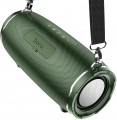Output power
The total power of all channels of the speaker system. The higher the power, the larger the size of the room in which the audio system can be used, however, more
powerful portable speakers usually have larger dimensions and weight.
Speaker synchronization
The model supports the ability
to synchronize the operation of several speakers connected to one signal source. This solution allows you to realize truly stereo sound, improve the quality and power of sound reproduction, and also expand the stereo panorama. The only thing is that both speakers must support the appropriate connection type. Different brands may have their own technologies for combining speakers (JBL Connect, JBL PartyBoost, Sony Party Chain), or maybe a universal TWS.
Features
—
Microphone for speakerphone. The ability to use portable speakers as a speakerphone system for conversations on a paired mobile phone. In this mode, the speakers connect to the device via Bluetooth, and the speech is transmitted to the interlocutor using the built-in microphone. The voice of the subscriber on the other end of the line is output not to the speaker of the phone, but directly through the speakers of the speaker system. This is often much more convenient than holding the phone close to the ear, or in situations when your hands are busy. In addition, speakerphone can be very useful if several people need to participate in the conversation.
—
NFC chip. NFC is a short-range wireless communication technology (about 10 cm). It allows for many different uses, but in portable speakers it is usually used as an addition to Bluetooth, making it easier to set up a communication. For example, a smartphone with an NFC module can simply be brought to a speaker with the same function — and both devices will automatically recognize each other, and the user will only need to confirm the communication.
—
Multipoint. The technology used in Bluetooth models allows the speaker to connect to several devices simultaneously. Thanks to this, you can, for example, listen to music from a laptop, and when a call comes in on your mobile phone, switch the speakers to a c
...onversation. Different manufacturers have their own features of this technology, and therefore, if the multipoint function is critical for you, you should separately clarify the details of its operation in the selected model.
— Bass Boost. A function that provides amplification of low frequencies — for powerful and rich bass. Often implemented as a single button, with which you can actually "turn the bass on and off." Bass Boost is more convenient than adjusting low frequencies using an equalizer; in addition, various special technologies can be used to enhance bass.
— Mobile application. The ability to operate the functions and settings of portable sound system through a mobile application for a smartphone or tablet. The device usually communicates with gadgets via the Bluetooth wireless protocol. The proprietary software may include tools for flexible sound adjustment (equalizer, bass boost, etc.), wireless communication management, sound source selection, etc. Also, the ability to update the firmware of portable sound system is often implemented through a mobile application.
— Light effects. Such effects can be different — from the simplest set of lights flashing at a constant frequency to advanced color music systems that produce multi-colored patterns in time with the music being played. In any case, this function has more of an entertaining meaning and does not affect the sound of the device in any way.Battery capacity
Theoretically, a
higher capacity allows to achieve greater battery life, but in fact, the operating time also depends on the power consumption of acoustics — and it can be very different, depending on the characteristics and design features. So this parameter is secondary, and when choosing it is worth paying attention not so much to the battery capacity, but to the directly claimed operating time (see below).
Battery life
Operating time of a portable audio system without connecting to an external power source (network or USB port, depending on the capabilities). Note that manufacturers tend to indicate battery life in their specifications under optimal conditions for energy saving: at low volume, without using additional functions, etc. Therefore, in fact, this indicator may be noticeably lower than the claimed one, and
speakers with a long operating time will not sound at full volume for the specified hours.
Charging time
The time it takes to charge a fully discharged device to 100% charge.
Waterproof
The presence in the design of the acoustics of
a protected housing that prevents dust and moisture from entering the sensitive electronic filling. The specific degree of such protection in different models may be different — some speakers are able to endure even complete immersion under water (
waterproof), others are designed only for exposure to moderate rain. Therefore, the specifics of the protected case should be clarified separately according to the manufacturer's official data. However, anyway, such speakers will be more resistant to bad weather and better suited for outdoor use than those that do not have dust and water protection; therefore, if you are choosing acoustics for outdoor trips, it makes sense to pay attention to models with this function.
Some models with this feature are officially IP certified. The IP index includes two digits — for example, IP54. The first digit indicates the degree of protection against dust, the second — from moisture; the higher the number, the higher the corresponding degree of protection, detailed data can be found in special sources.

